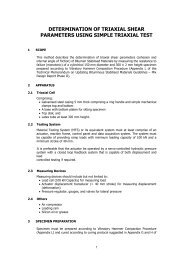Vibratory Compaction Procedure - Asphalt Academy
Vibratory Compaction Procedure - Asphalt Academy
Vibratory Compaction Procedure - Asphalt Academy
- No tags were found...
Create successful ePaper yourself
Turn your PDF publications into a flip-book with our unique Google optimized e-Paper software.
5. PREPARATION OF SPECIMENS<br />
5.1 Preparing the vibratory hammer<br />
Fix the mounting head and appropriate tamping foot to the vibratory hammer and fit<br />
hammer onto guide rods. Place 10kg surcharge weight onto mounting head and fasten<br />
tightly. Using the pulley system raise the vibratory to the maximum height it can be raised or<br />
to an adequate height that will allow operator to work safely beneath the vibratory hammer.<br />
5.2 Preparing the mould<br />
Clean the mould, collar and base plate. Lubricate the inside mould wall with a very light<br />
application of lubricating grease or non-stick spray. This allows for easy removal of the<br />
compacted sample and easy cleaning of the mould thereafter.<br />
Fix the mould to the base of the compaction frame directly below the foot piece of the<br />
vibratory hammer. Place a sheet of circular filter paper at the bottom of the mould. Lower<br />
the vibratory hammer into the mould, checking that the vibratory hammer is perpendicular to<br />
the base of the mould i.e. the tamping foot is flat on the base with no point of the foot<br />
raised. Allow the vibratory hammer to rest in the mould with no material present. Where the<br />
lower end of sleeve of the mounting head rests on the guide rod, mark that position clearly<br />
on the vertical guide using the suitable marker (non-erasable).<br />
5.3 <strong>Compaction</strong><br />
The prepared material should be mixed immediately prior to compaction and be compacted<br />
at a temperature between 22 and 25 o C.<br />
The number of layers for each type of specimen required is shown below.<br />
Phase Level 1 Level 2 Level 3<br />
Test ITS ITS UCS Triaxial<br />
Sample diameter (mm) 101 152 152 152<br />
Sample height (mm) 65 95 125 300<br />
Approximate volume of compacted<br />
specimen – Vcs in Eq 4 (cm 3 )<br />
520 1725 2270 5445<br />
Surcharge on Hammer 5kg 10kg 10kg 10kg<br />
Number of layers 1 2 2 5<br />
<strong>Compaction</strong> time per layer (secs)<br />
BSM-emulsion<br />
BSM-foam<br />
(per side)<br />
10<br />
10<br />
Tamping foot diameter (mm) 100 150 150 150<br />
The approximate quantity of material required for each layer will be the total quantity of<br />
material based on the maximum dry density, the optimum moisture content and volume of<br />
compacted specimen (See Equation 4). The quantity of material for each layer will be the<br />
total quantity of material divided by the number of layers. For multi-layer specimens slight<br />
adjustments might be necessary for consecutive layers to achieve the recommended<br />
height.<br />
4<br />
15<br />
25<br />
15<br />
25<br />
15<br />
25












